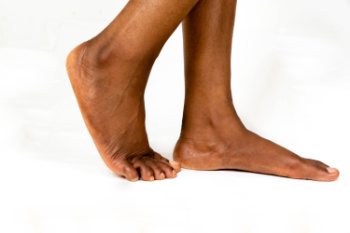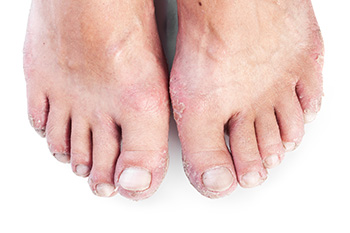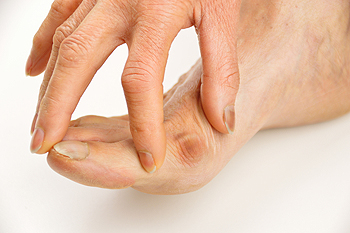Connect With Us
Blog
Items filtered by date: June 2024
Treatment of Adult Acquired Flat Feet

Adult-acquired flatfoot, also known as posterior tibial tendon dysfunction, can be a source of significant discomfort for many adults. Adult-acquired flatfoot develops when the posterior tibial tendon weakens, causing the arch of the foot to collapse gradually. Symptoms can include pain along the inside of the ankle, swelling, difficulty standing on tiptoes, and increased discomfort during weight-bearing activities. A podiatrist can perform an assessment of your foot's flexibility and alignment, and may order X-rays or other imaging techniques to assess the condition of the tendon and bones. Treatment options typically start conservatively with custom orthotics or ankle braces to support the foot and alleviate pain. Activity modifications and anti-inflammatory medications may also be recommended. In cases where conservative treatments do not provide sufficient relief, surgical tendon repair or fusion procedures may be considered to restore stability and function to the affected foot. If you are experiencing problems related to flat feet, it is suggested that you schedule an appointment with a podiatrist for treatment.
Flatfoot is a condition many people suffer from. If you have flat feet, contact Janale Beckford, DPM from Tampa Podiatrists . Our doctor will treat your foot and ankle needs.
What Are Flat Feet?
Flatfoot is a condition in which the arch of the foot is depressed and the sole of the foot is almost completely in contact with the ground. About 20-30% of the population generally has flat feet because their arches never formed during growth.
Conditions & Problems:
Having flat feet makes it difficult to run or walk because of the stress placed on the ankles.
Alignment – The general alignment of your legs can be disrupted, because the ankles move inward which can cause major discomfort.
Knees – If you have complications with your knees, flat feet can be a contributor to arthritis in that area.
Symptoms
- Pain around the heel or arch area
- Trouble standing on the tip toe
- Swelling around the inside of the ankle
- Flat look to one or both feet
- Having your shoes feel uneven when worn
Treatment
If you are experiencing pain and stress on the foot you may weaken the posterior tibial tendon, which runs around the inside of the ankle.
If you have any questions please feel free to contact our office located in Tampa, FL . We offer the newest diagnostic and treatment technologies for all your foot and ankle needs.
Are You Suffering From Nerve Damage?
Common Foot Injuries for Ballerinas

Ballerinas often face various foot injuries due to the intense demands of ballet. One common injury is the stress fracture, resulting from repetitive impact and overuse, particularly in the metatarsal bones. Tendonitis, especially affecting the Achilles tendon, occurs from overextension and strain during jumps and pointe work. Blisters and calluses develop from friction against tight-fitting ballet shoes. Additionally, sprained ankles are frequent due to the constant balancing and quick directional changes. Sesamoiditis, an inflammation of the small bones beneath the big toe, is another injury caused by the pressure of pointe work. Plantar fasciitis, characterized by heel pain, results from excessive strain on the arch of the foot. These injuries highlight the physical challenges ballerinas face, emphasizing the importance of proper technique, conditioning, and foot care in their training. Foot pain can temporarily stop a dancer’s movements. If this applies to you, it is suggested that you confer with a podiatrist who can provide you with relief and treatment methods.
Foot Pain
Foot pain can be extremely painful and debilitating. If you have a foot pain, consult with Janale Beckford, DPM from Tampa Podiatrists . Our doctor will assess your condition and provide you with quality foot and ankle treatment.
Causes
Foot pain is a very broad condition that could be caused by one or more ailments. The most common include:
- Bunions
- Hammertoes
- Plantar Fasciitis
- Bone Spurs
- Corns
- Tarsal Tunnel Syndrome
- Ingrown Toenails
- Arthritis (such as Gout, Rheumatoid, and Osteoarthritis)
- Flat Feet
- Injury (from stress fractures, broken toe, foot, ankle, Achilles tendon ruptures, and sprains)
- And more
Diagnosis
To figure out the cause of foot pain, podiatrists utilize several different methods. This can range from simple visual inspections and sensation tests to X-rays and MRI scans. Prior medical history, family medical history, and any recent physical traumatic events will all be taken into consideration for a proper diagnosis.
Treatment
Treatment depends upon the cause of the foot pain. Whether it is resting, staying off the foot, or having surgery; podiatrists have a number of treatment options available for foot pain.
If you have any questions, please feel free to contact our office located in Tampa, FL . We offer the newest diagnostic and treatment technologies for all your foot care needs.
Help for Psoriatic Arthritis of the Feet
 Psoriasis of the feet, particularly palmoplantar psoriasis is a chronic skin condition characterized by thickened, red, and scaly patches on the soles. This form is often accompanied by painful fissures and can severely impact mobility. Another variant, localized pustular psoriasis, presents as pus-filled blisters surrounded by inflamed skin. Nail involvement is common, leading to pitting, discoloration, and onycholysis, or separation of the nail from the nail bed. Triggers for psoriasis include stress, infections, skin injuries, and certain medications. Diagnosis is primarily clinical, supported by a skin biopsy if necessary. Treatments range from topical therapies like corticosteroids and vitamin D analogs to systemic treatments, including biologics and oral medications for more severe cases. Phototherapy is another effective option. In refractory cases, surgical intervention may be considered to remove painful, thickened plaques. If you have discomfort in the feet from psoriasis, it is suggested that you schedule an appointment with a podiatrist for optimal management and personalized care.
Psoriasis of the feet, particularly palmoplantar psoriasis is a chronic skin condition characterized by thickened, red, and scaly patches on the soles. This form is often accompanied by painful fissures and can severely impact mobility. Another variant, localized pustular psoriasis, presents as pus-filled blisters surrounded by inflamed skin. Nail involvement is common, leading to pitting, discoloration, and onycholysis, or separation of the nail from the nail bed. Triggers for psoriasis include stress, infections, skin injuries, and certain medications. Diagnosis is primarily clinical, supported by a skin biopsy if necessary. Treatments range from topical therapies like corticosteroids and vitamin D analogs to systemic treatments, including biologics and oral medications for more severe cases. Phototherapy is another effective option. In refractory cases, surgical intervention may be considered to remove painful, thickened plaques. If you have discomfort in the feet from psoriasis, it is suggested that you schedule an appointment with a podiatrist for optimal management and personalized care.
Arthritis can be a difficult condition to live with. If you are seeking treatment, contact Janale Beckford, DPM from Tampa Podiatrists . Our doctor can provide the care you need to keep you pain-free and on your feet.
Arthritic Foot Care
Arthritis is a term that is commonly used to describe joint pain. The condition itself can occur to anyone of any age, race, or gender, and there are over 100 types of it. Nevertheless, arthritis is more commonly found in women compared to men, and it is also more prevalent in those who are overweight. The causes of arthritis vary depending on which type of arthritis you have. Osteoarthritis for example, is often caused by injury, while rheumatoid arthritis is caused by a misdirected immune system.
Symptoms
- Swelling
- Pain
- Stiffness
- Decreased Range of Motion
Arthritic symptoms range in severity, and they may come and go. Some symptoms stay the same for several years but could potentially get worse with time. Severe cases of arthritis can prevent its sufferers from performing daily activities and make walking difficult.
Risk Factors
- Occupation – Occupations requiring repetitive knee movements have been linked to osteoarthritis
- Obesity – Excess weight can contribute to osteoarthritis development
- Infection – Microbial agents can infect the joints and trigger arthritis
- Joint Injuries – Damage to joints may lead to osteoarthritis
- Age – Risk increases with age
- Gender –Most types are more common in women
- Genetics – Arthritis can be hereditary
If you suspect your arthritis is affecting your feet, it is crucial that you see a podiatrist immediately. Your doctor will be able to address your specific case and help you decide which treatment method is best for you.
If you have any questions, please feel free to contact our office located in Tampa, FL . We offer the newest diagnostic and treatment technologies for all your foot care needs.
Bunion Relief
 A bunion is a bony bump that forms on the joint at the base of the big toe, causing it to deviate towards the other toes. This condition, known as hallux valgus, can result from genetic predisposition, wearing tight or narrow shoes, arthritis, or stress on the foot. Symptoms include pain, swelling, redness, and difficulty in walking. Additionally, the skin over the bunion may gradually become thickened and tender. Diagnosis typically involves a physical examination and X-rays to assess the severity and underlying bone structure. Treatment options range from conservative methods such as wearing wider shoes, using orthotic devices, and taking anti-inflammatory medications, to more invasive procedures like bunion surgery for severe cases. Untreated bunions can lead to complications such as chronic pain, bursitis, hammertoe, and difficulty finding comfortable footwear. If you have a bunion that is causing you discomfort, it is suggested that you schedule an appointment with a podiatrist for a tailored treatment plan.
A bunion is a bony bump that forms on the joint at the base of the big toe, causing it to deviate towards the other toes. This condition, known as hallux valgus, can result from genetic predisposition, wearing tight or narrow shoes, arthritis, or stress on the foot. Symptoms include pain, swelling, redness, and difficulty in walking. Additionally, the skin over the bunion may gradually become thickened and tender. Diagnosis typically involves a physical examination and X-rays to assess the severity and underlying bone structure. Treatment options range from conservative methods such as wearing wider shoes, using orthotic devices, and taking anti-inflammatory medications, to more invasive procedures like bunion surgery for severe cases. Untreated bunions can lead to complications such as chronic pain, bursitis, hammertoe, and difficulty finding comfortable footwear. If you have a bunion that is causing you discomfort, it is suggested that you schedule an appointment with a podiatrist for a tailored treatment plan.
If you are suffering from bunions, contact Janale Beckford, DPM of Tampa Podiatrists . Our doctor can provide the care you need to keep you pain-free and on your feet.
What Is a Bunion?
A bunion is formed of swollen tissue or an enlargement of boney growth, usually located at the base joint of the toe that connects to the foot. The swelling occurs due to the bones in the big toe shifting inward, which impacts the other toes of the foot. This causes the area around the base of the big toe to become inflamed and painful.
Why Do Bunions Form?
Genetics – Susceptibility to bunions are often hereditary
Stress on the feet – Poorly fitted and uncomfortable footwear that places stress on feet, such as heels, can worsen existing bunions
How Are Bunions Diagnosed?
Doctors often perform two tests – blood tests and x-rays – when trying to diagnose bunions, especially in the early stages of development. Blood tests help determine if the foot pain is being caused by something else, such as arthritis, while x-rays provide a clear picture of your bone structure to your doctor.
How Are Bunions Treated?
- Refrain from wearing heels or similar shoes that cause discomfort
- Select wider shoes that can provide more comfort and reduce pain
- Anti-inflammatory and pain management drugs
- Orthotics or foot inserts
- Surgery
If you have any questions, please feel free to contact our office located in Tampa, FL . We offer the newest diagnostic and treatment technologies for all your foot care needs.

